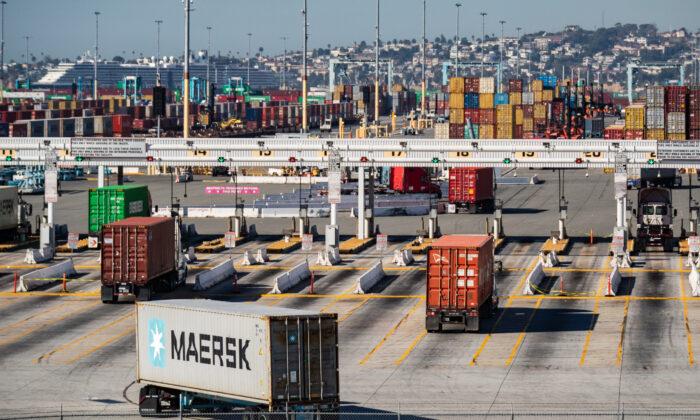For years, Thomas Moore used to drive his truck into California to pick up cargo loads. He refuses to do that now.
He could tick off a mile-long list of reasons: overregulation, long wait times at the ports, too much traffic, and a lack of facilities for drivers.
“We just refuse to go into California,” Moore told The Epoch Times. “At 63 years old, I just can’t do it anymore.”
He’s not alone, he said.
“I would say [there are] probably 10,000 per day who refuse to drive in California or New York. Just refuse to go there. They just won’t have anything to do with it,” Moore said from his home in Tucson, Arizona, on Nov. 2.
“You’re going to find a lot of anti-Biden people in truck driving, but I’m not one of them. I wear a mask and I’m vaccinated.”
The ports of Los Angeles and Long Beach are continuing to sort through a container logjam at the terminals this week as cargo ships wait for their turn to offload. Trucker shortages were one of the many reasons for the supply chain crisis that has placed the Southern California ports at center stage recently.

The twin ports of Los Angeles and Long Beach have implemented new fines to attempt to spur faster clearing of the backlog of containers from its terminals. The ports will charge $100 a day for each container left for more than nine days if the container will be moved by truck. Rail carriers will be charged after six days.
Operators appeared to answer the call. According to statistics provided by the Port of Long Beach, truckers and rail carriers are making progress in moving cargo out of the terminals.
“Loaded import containers dwelling 9 days or longer in port terminals numbered 25,000 one week ago, and have declined 19 percent since then, showing these containers are being taken out of terminals,” port spokesman Lee Peterson told The Epoch Times in an email.
Meeting Regulations
Truckers coming into the ports face some of the country’s strictest regulations at the ports of Los Angeles and Long Beach. In California, they are restricted to moving one container at a time. They are also restricted to driving newer trucks, with engines that meet California Air Resources Board (CARB) regulations.California decided in 2008 to put a deadline on implementing emission standards for vehicles to meet the new standards, which started in January 2020.
By Dec. 31, 2022, no vehicles will be allowed on the roads that are not 2010 or newer without emission components that comply with the CARB regulations. That’s caused many truckers to steer clear of the state, Moore said.

Another regulatory issue that makes California unappealing for Moore is that he can no longer run his truck engine during the night to heat or cool his cab. The state tickets drivers who run their engines and purchasing special air conditioning and heating equipment is expensive, he said.
The auxiliary power units can cost from $8,500 to $13,000 per installed unit, according to the North American Council for Freight Efficiency. They can cost about $3,000 each year to maintain. The small units can keep the air conditioning and heaters running inside the truck cabs without the need to run the truck engines.
In California, a driver of a diesel-fueled vehicle with a gross vehicle weight rating of more than 10,000 pounds may not idle its engine for more than five minutes at any location and isn’t allowed to operate a diesel-fueled auxiliary power system for more than five minutes when located within 100 feet of a restricted area.
Operators of trucks equipped with sleeper berths must shut off the engine when idling for more than five minutes at any location and can be fined. Meanwhile, the state’s Department of Motor Vehicles won’t register, renew, or transfer a registration for any vehicle operator with a ticket until it’s cleared.
A truck shortage has also caused some problems for companies and may be adding to the crisis, according to Paula Ventura of Monarch Truck Center.
National Shortages
A change in rules for obtaining commercial driver’s licenses (CDL) has added to the national shortage of drivers, even though many opportunities exist for drivers, according to the operators of Elite Trade Academy in Dallas.“There’s really a lot of opportunity in the truck driving industry. Drivers are so needed right now. Starting in February, when the regulations change and you have to attend an approved school, it’s really cutting down on the number of schools available to the people who are interested in getting a CDL. Most CDL schools have a waitlist,” said co-founder Sierra Mosby, during an interview this month.
The school’s program takes about four weeks and about 200 hours of additional training to receive a CDL.
American Trucking Associations’ (ATA) chief economist Bob Costello said on Oct. 25, the current driver shortage has risen to a record high of 80,000.
“Since we last released an estimate of the shortage, there has been tremendous pressure on the driver pool,” Costello said. “Increased demand for freight, pandemic-related challenges from early retirements, closed driving schools and DMVs, and other pressures are really pushing up demand for drivers and subsequently the shortage.”

The ATA pointed to the high average age of drivers, the inability of drivers to pass a drug test and the increasing number of states legalizing marijuana, and the lack of truck parking spots where drivers can stop to rest.
Moore said the lack of driver accommodations was one reason he no longer takes jobs in the Southern California area, especially at the ports.
The lack of parking, no facilities at the ports for drivers to use the bathrooms, the traffic, and the driving laws requiring truck drivers to stay in the right lanes, causing truckers to constantly adjust their speeds.
Newest Regulations
The Los Angeles Board of Harbor Commissioners unanimously approved on Nov. 4 a program that will charge cargo owners for using trucks that don’t meet rigorous clean air standards. The port will begin collecting fines on April 1, 2022, at $10 per container hauled by a nonexempt truck. The Port of Long Beach also is implementing the fine.The board initiated the program to the transition of zero-emission trucks at the Port of Los Angeles. Zero-emission trucks are exempt from the rate, along with trucks that meet or exceed California’s low nitrogen oxide standard through Dec. 31, 2027.
Loaded containers entering or leaving marine terminals by on-dock rail also will be exempt.
The rate is set to expire on Dec. 31, 2034, according to the port.





